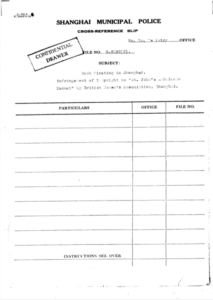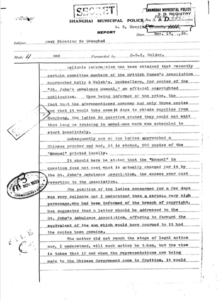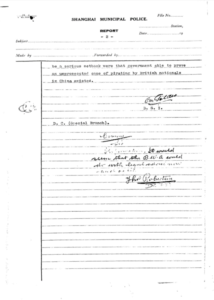‘Book pirating in Shanghai, an infringement of copyright’, not the most gripping title in the world. However, the task for this week’s tutorial was set, we had to find source material on law and order in Shanghai, and I thought this may offer an interesting alternative to the other material my classmates would be producing. As soon as I opened up the document I was rewarded, on its first page the word ‘confidential’ was stamped across the report, on the next page more stamped lettering, this time spelling out ‘secret’. At this point my interest was piqued and so I delved further into the document, the report revealed a conspiracy in which an anonymous member within the higher echelons of the international settlement had stepped in to cover up the actions of the British Women’s Association. The Association had pirated a first aid manual from the St. John’s Ambulance, printing 240 copies.
The source could be easily explained as a powerful man exercising his authority to protect a wife, friend or relative who was part of the association. However, this fails to explain the concern of the writer of the report, who states that if the Chinese were to find out there would be an international incident. Instead the source underscores the conflict between the racial views of the British, the state of the international settlement and the Chinese opinions of it. Firstly, the actions of these women contradict the prevailing ideas of racial superiority held by the British. The Chinese were considered to be ‘racially unequal’ when compared to Europeans and so required European overlordship so as to civilise them.[1] The actions of the Women’s Association undermined this, offering evidence of immoral activity among the British, a double standard to do with the implementation of law, as well as presenting men of status within the colony as being unable to control their women (within the confides of the patriarchal society they were operating in). These thoughts would have trouble the British authorities who were trying to navigate an increasingly politically complicated Shanghai, with Chinese nationalist, Chinese communists and Japanese nationalists all fighting for control.
This concern mirrors constant attempts by the Chinese to undermine the International Settlement. Chiang Kai-shek had made it clear in 1927 that the purpose of new Shanghai municipal government was to bring law and order to one of the most crime ridden cities in the world.[2] A city which had been failed by the International community. These opinions by the 1930’s had spread throughout Chinese society, with literary scholars in Beijing accusing writers from Shanghai of interlacing their stories with sex and decadence.[3] It can, therefore, be seen that the British establishment saw it as prudent to suppress this incident so as to not provide the Chinese with evidence of perceived inequalities and inefficiencies within the government of the International Settlement.
[1] Robert Bickers, ‘Shanghailanders: The Formation and Identity of the British Settler Community in Shanghai 1843-1937’, Past & Present 159 (1998), p. 184.
[2] Frederic Wakeman, Jr., ‘Policing Modern Shanghai’, The China Quarterly 115 (1988), pp. 419.
[3] David Koren, ‘Shanghai: The Biography of a City’ in Jan Kolen, Johannes Renes, Rita Hermans (ed.), Landscape Biographies (Amsterdam, 2015), p. 267.
Bibliography:
Bickers, Robert, ‘Shanghailanders: The Formation and Identity of the British Settler Community in Shanghai 1843-1937’, Past & Present 159 (1998), p. 161-211.
Koren, David, ‘Shanghai: The Biography of a City’ in Jan Kolen, Johannes Renes, Rita Hermans (ed.), Landscape Biographies (Amsterdam, 2015), pp. 253 – 282.
Wakeman,Frederic, Jr., ‘Policing Modern Shanghai’, The China Quarterly 115 (1988), pp. 408 – 440.
Source:


